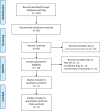Comparison of nephroscopy and cystoscopy used in the treatment of bladder stones: a systematic review and meta-analysis of randomized controlled trials
- PMID: 34972510
- PMCID: PMC8720207
- DOI: 10.1186/s12893-021-01461-3
Comparison of nephroscopy and cystoscopy used in the treatment of bladder stones: a systematic review and meta-analysis of randomized controlled trials
Abstract
Background: A systematic review and meta-analysis was conducted to compare the safety and efficiency of nephroscopy and cystoscopy in transurethral cystolithotripsy (TUCL) for bladder stones (BS).
Methods: The PubMed, Web of Science, Embase, EBSCO, and Cochrane Library databases were searched up to January 2021 for studies assessing the effect of different types of endoscopes among patients who underwent TUCL. The search strategy and study selection process were in accordance with the PRISMA statement.
Results: Five randomized controlled trials were included in the meta-analysis. The results showed no difference in stone-free rate (RR = 1.00, CI = 0.98-1.02, p = 1.00) between the two groups and nonsignificant heterogeneity (I2 = 0%, p = 1.00), and all patients were rendered stone free. Use of the nephroscope significantly shortened the operative time compared with the cystoscope group (RR= - 26.26, CI = - 35.84 to - 16.68, p < 0.00001), and there was significant heterogeneity (I2= 87%, p < 0.00001). There was no significant difference in mean urethral entries (RR = 0.66, CI = - 0.71 to - 2.04, p = 0.35), hospitalization (MD = 0.08, 95% CI = - 0.07 to 0.23, p = 0.31) or total complication rate (RR=1.37, 95% CI = 0.47-4.00, p = 0.56) between the two groups.
Conclusions: In conclusion, this systematic review demonstrates that both nephroscopy and cystoscopy have high stone clearance efficiency, low rates of complications and short hospitalizations. The mean urethral entries depend on the treatment method for large stone fragments. However, the use of nephroscopy can significantly reduce the operative time.
Keywords: BS; Cystoscope; Endoscopic treatments; Nephroscope; Transurethral.
© 2021. The Author(s).
Conflict of interest statement
The authors declare no competing interests.
Figures
Similar articles
-
Treatment of Bladder Stones in Adults and Children: A Systematic Review and Meta-analysis on Behalf of the European Association of Urology Urolithiasis Guideline Panel.Eur Urol. 2019 Sep;76(3):352-367. doi: 10.1016/j.eururo.2019.06.018. Epub 2019 Jul 13. Eur Urol. 2019. PMID: 31311676
-
Prospective randomized comparison of three endoscopic modalities used in treatment of bladder stones.Urologia. 2016 May 24;83(2):87-92. doi: 10.5301/uro.5000171. Epub 2016 Apr 9. Urologia. 2016. PMID: 27103095 Clinical Trial.
-
Mini-percutaneous cystolithotripsy (mPCCL) versus transurethral cystolithotripsy (TUC) in pre-school children: Prospective comparative non-randomized outcomes over 8 years.J Pediatr Urol. 2020 Dec;16(6):782.e1-782.e6. doi: 10.1016/j.jpurol.2020.09.021. Epub 2020 Sep 28. J Pediatr Urol. 2020. PMID: 33051129
-
Comparison of three different endoscopic approaches in the treatment of bladder calculi.Yeungnam Univ J Med. 2019 Jan;36(1):16-19. doi: 10.12701/yujm.2019.00045. Epub 2018 Dec 19. Yeungnam Univ J Med. 2019. PMID: 31620607 Free PMC article.
-
Preoperative Alpha-Blockers for Ureteroscopy for Ureteral Stones: A Systematic Review and Meta-Analysis of Randomized Controlled Trials.J Endourol. 2020 Jan;34(1):33-41. doi: 10.1089/end.2019.0520. Epub 2019 Oct 9. J Endourol. 2020. PMID: 31507224
Cited by
-
Endourological versus open cystolithotomy for bladder stone management among children: A systematic review and meta-analysis.F1000Res. 2023 Feb 2;12:124. doi: 10.12688/f1000research.129270.1. eCollection 2023. F1000Res. 2023. PMID: 39291145 Free PMC article.
-
Effect of flexible cystoscopy combined with flexible ureteroscopy on short-term outcomes in patients with complex renal stones.Am J Transl Res. 2024 Sep 15;16(9):4515-4525. doi: 10.62347/NZGO3556. eCollection 2024. Am J Transl Res. 2024. PMID: 39398599 Free PMC article.
References
-
- Wagner CA. Etiopathogenic factors of urolithiasis. Arch Espanol Urol. 2021;74(1):16–23. - PubMed
Publication types
MeSH terms
Grants and funding
LinkOut - more resources
Full Text Sources




